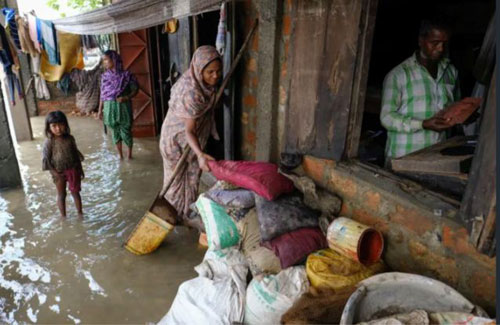Water levels were slowly receding Thursday in major rivers in Bangladesh’s flood-hit northeast, bringing hopes of relief to millions of Bangladeshis, but woes continued in India’s northeast, where 5.5 million people remained affected, officials said.
Up to 78 people have died in floods and 17 oth-ers in landslides in India’s Assam state, while at least 42 monsoon-related deaths have been recorded in Bangladesh since last month, when floods began ravaging parts of the two South Asian countries, forcing millions to take shelter away from their homes.
Bangladesh’s Flood Forecasting and Warning Center said water in all major rivers in the country’s northeast was receding, but downstream water levels in central and eastern parts of the country could rise over the coming day.
Aid workers said the pace of decline in water levels in the northeast was very slow. “Yes, it’s going down, but the pace is insignificant,” said Tanvir Rahman Dhaly, an official of non-profit aid agency BRAC.
Dhaly said only 15% to 20% of people in the worst-affected districts of Sunamganj and Sylhet bordering India have left shelters there.
“Children and pregnant women are suffering a lot. They need food, they need care and medical atten-tion,” he said.
Sajedul Hasan, BRAC’s director of disaster risk management, said many families had lost their cattle.
“I just visited one family which had three cows before the flood hit. They left them behind and now when they returned home there is no trace of them,” he said.
Other families still have their cattle, but are struggling to provide them with feed.
In India’s Assam state, there was little sign of hope. “I am touring the worst-hit southern Assam dis-tricts today. The army and air force continue to be engaged in relief and rescue operations,” said the state’s top elected official, Himanta Biswa Sarma.
Authorities said more than 250,000 people have taken shelter in nearly 1,000 relief camps.
“Hundreds of medical doctors and paramedics are deployed to take care of sick people and tackle any post-flood disease outbreaks,” said Assam Health Minister Keshav Mahanta.
Scientists say climate change has made the monsoon season more variable, with much of the rain normally expected to fall over a year arriving in a space of weeks.
The northeastern Indian state of Meghalaya re-ceived nearly three times its average June rainfall in just the first three weeks of the month, and neighboring Assam received twice its monthly aver-age in the same period. Several rivers, including one of Asia’s largest, flow downstream from the two states into the Bay of Bengal in low-lying Bangla-desh, a densely populated delta nation.
Every year about 3.5 million Bangladeshis face flooding when rivers overflow their banks, according to a 2015 analysis by the World Bank Institute.
Bangladesh is considered one of the most vul-nerable countries to climate change, and the poor are disproportionately impacted. Prime Minister Sheikh Hasina said Wednesday that Bangladesh will have to live with such disasters, so infrastructure should be built to better protect its people.—AP










